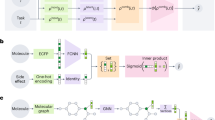Abstract
Lead Optimization is a complex process, whereby a large number of interacting entities give rise to molecular structures whose properties should be optimized in order to be considered for drug development. We will study molecular systems that are characterized by high dimensionality and dynamically interacting networks with the goal of discovering the optimal molecules with respect to the set of essential properties. Currently, the research involves the screening and the identification of molecule with desirable properties from large molecule libraries. Lead Optimization is a multi-objective optimization problem. The classical approaches involving in-vitro laboratory analysis are time consuming and very expensive. To address this problem, we propose in this paper an in-silico approach: Lead Optimization based on Neural Network (NN) model in order to help the chemist in the lab experimentation by requiring a small set of real laboratory tests. We propose and estimate a predictive network model to derive a simultaneous optimal multi-response property following a single and multi-objective optimization procedure. We adopt different architectures in this study and we compare our procedure with other state-of-the-art method showing the better performance of our approach.
Access this chapter
Tax calculation will be finalised at checkout
Purchases are for personal use only
Similar content being viewed by others
References
Benfenati, E., Gini, G., Hoffmann, S., Luttik, R.: Comparing in vivo, in vitro and in silico methods and integrated strategies for chemical assessment: problems and prospects. Altern. Lab. Anim. 38(2), 153–166 (2010)
Borrotti, M., De March, D., Slanzi, D., Poli, I.: Designing lead optimisation of mmp-12 inhibitors. Comput. Math. Methods Med. 2014 (2014)
Chollet, F., et al.: Keras (2015). https://keras.io
Devillers, J.: Neural Networks in QSAR and Drug Design. Academic Press, Cambridge (1996)
Devulpalli, K.: Neural networks for classification and regression. Biomed. Biostat. Int. J. 2(6), 00046 (2015)
Di, L., Kerns, E.H.: Drug-like Properties: Concepts, Structure Design and Methods from ADME to Toxicity Optimization. Academic press, Cambridge (2015)
Ghasemi, F., Mehridehnavi, A., Perez-Garrido, A., Perez-Sanchez, H.: Neural network and deep-learning algorithms used in QSAR studies: merits and drawbacks. Drug Discov. Today 23(10), 1784–1790 (2018)
Giovannelli, A., Slanzi, D., Khoroshiltseva, M., Poli, I.: Model-based lead molecule design. In: Rossi, F., Piotto, S., Concilio, S. (eds.) WIVACE 2016. CCIS, vol. 708, pp. 103–113. Springer, Cham (2017). https://doi.org/10.1007/978-3-319-57711-1_9
Grebner, C., Matter, H., Plowright, A.T., Hessler, G.: Automated de-novo design in medicinal chemistry: which types of chemistry does a generative neural network learn? J. Med. Chem. 63, 8809–8823 (2020)
H Nilar, S., B Lakshminarayana, S., Ling Ma, N., H Keller, T., Blasco, F., W Smith, P.: Artificial neural network analysis of pharmacokinetic and toxicity properties of lead molecules for dengue fever, tuberculosis and malaria. Curr. Comput.-Aided Drug Des. 12(1), 52–61 (2016)
Jiménez-Luna, J., et al.: DeltaDelta neural networks for lead optimization of small molecule potency. Chemical Science 10(47), 10911–10918 (2019)
Kadurin, A., et al.: The cornucopia of meaningful leads: applying deep adversarial autoencoders for new molecule development in oncology. Oncotarget 8(7), 10883 (2017)
Kwon, Y., Shin, W.H., Ko, J., Lee, J.: AK-score: Accurate protein-ligand binding affinity prediction using the ensemble of 3D-convolutional neural network. Int. J. Mol. Sci. 21(22), 8424 (2020)
Pickett, S.D., Green, D.V., Hunt, D.L., Pardoe, D.A., Hughes, I.: Automated lead optimization of mmp-12 inhibitors using a genetic algorithm. ACS Med. Chem. Lett. 2(1), 28–33 (2011)
Slanzi, D., Mameli, V., Khoroshiltseva, M., Poli, I.: Multi-objective optimization in high-dimensional molecular systems. In: Pelillo, M., Poli, I., Roli, A., Serra, R., Slanzi, D., Villani, M. (eds.) WIVACE 2017. CCIS, vol. 830, pp. 284–295. Springer, Cham (2018). https://doi.org/10.1007/978-3-319-78658-2_21
Tautermann, C.S.: Current and future challenges in modern drug discovery. In: Heifetz, A. (ed.) Quantum Mechanics in Drug Discovery. MMB, vol. 2114, pp. 1–17. Springer, New York (2020). https://doi.org/10.1007/978-1-0716-0282-9_1
Tieleman, T., Hinton, G.: Lecture 6.5-rmsprop: divide the gradient by a running average of its recent magnitude. COURSERA: Neural Netw. Mach. Learn 4(2), 26–31 (2012)
Author information
Authors and Affiliations
Corresponding author
Editor information
Editors and Affiliations
Rights and permissions
Copyright information
© 2021 Springer Nature Switzerland AG
About this paper
Cite this paper
Dagnew, T.M., Silvestri, C., Slanzi, D., Poli, I. (2021). A Neural Network Model for Lead Optimization of MMP12 Inhibitors. In: Del Bimbo, A., et al. Pattern Recognition. ICPR International Workshops and Challenges. ICPR 2021. Lecture Notes in Computer Science(), vol 12664. Springer, Cham. https://doi.org/10.1007/978-3-030-68799-1_23
Download citation
DOI: https://doi.org/10.1007/978-3-030-68799-1_23
Published:
Publisher Name: Springer, Cham
Print ISBN: 978-3-030-68798-4
Online ISBN: 978-3-030-68799-1
eBook Packages: Computer ScienceComputer Science (R0)





